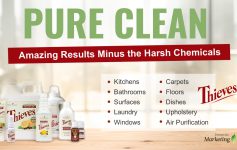
The BIG Problem
Since learning about environmental health in naturopathic medical school, I’ve been a woman on a mission to educate others on how the various chemicals and toxins we are exposed to everyday negatively affect our health. In fact, I just posted another update on the Trouble with Triclosan.
One of my biggest drivers for getting the word out is the accumulating effects that are spreading to future generations and harming vulnerable populations, especially our children. I previously explored the evidence on how parents’ choices in the products that they use around their children will have consequences on their little ones’ ongoing development. I also gave parents-to-be a list of resources and suggestions to mitigate the risks of exposures on their new bundle of joy.
Just today, I read another concerning review that sparked my passion to spread the word. The article was in Environmental Health Perspectives from 2012. The author sought to determine the impact of environmental chemicals on neurodevelopment in children. He painstakingly analyzed the literature and thoroughly revealed potential limitations and biases. Using total number of Full Square IQ Points (FSIQ) lost as a measurement, it was concluded that the contributions are substantial, even with the fact that just three of the thousands of chemicals in our world had enough quality data for effective analysis! The abstract reads:
Objective: The objective was to develop a strategy for taking into account the distribution (or incidence/prevalence) of a risk factor, as well as its effect size, in order to estimate its population impact on neurodevelopment of children.
Methods: The total numbers of Full-Scale IQ points lost among U.S. children 0–5 years of age were estimated for chemicals (methylmercury, organophosphate pesticides, lead) and a variety of medical conditions and events (e.g., preterm birth, traumatic brain injury, brain tumors, congenital heart disease).
Discussion: Although the data required for the analysis were available for only three environmental chemicals (methylmercury, organophosphate pesticides, lead), the results suggest that their contributions to neurodevelopmental morbidity are substantial, exceeding those of many nonchemical risk factors.
Conclusion: A method for comparing the relative contributions of different risk factors provides a rational basis for establishing priorities for reducing neurodevelopmental morbidity in children.
Considering the fact that a total of 287 chemicals were found in a sample of 10 babies’ umbilical cord in a 2004 study by the Environmental Working Group (EWG) and Commonweal, can you imagine the effects of the total body burden in little ones today! The EWG stated over 10 years ago:
Of the 287 chemicals we detected in umbilical cord blood, we know that 180 cause cancer in humans or animals, 217 are toxic to the brain and nervous system, and 208 cause birth defects or abnormal development in animal tests. The dangers of pre- or post-natal exposure to this complex mixture of carcinogens, developmental toxins and neurotoxins have never been studied.
It’s not just babies either! Here’s what I wrote a few years ago on adult’s total body burden:
The alarming amount of toxins and chemicals released into our environment continues to rise. According to the U.S. Department of Health and Human Services Toxicology Program, “More than 80,000 chemicals are registered for use in the United States. Each year, an estimated 2,000 new ones are introduced for use in such everyday items as foods, personal care products, prescription drugs, household cleaners, and lawn care products.” 2
In 2009, the Center for Disease Control and Prevention (CDC) released their “Fourth National Report on Human Exposure to Environmental Chemicals.” This 529-page “summary” of the CDC’s National Health and Nutrition Examination Survey (NHANES) stated that there were over 200 chemicals present in the average volunteer. 75 of these chemicals had never been seen in previous reports.3
Since this report’s release, the CDC has issued several updated tables4-5 which list even more new chemicals that are being monitored as potential harmful or toxic substances. The latest Updated Table from February 2015 listed a total of 265 chemicals, in which 65 were new and 139 were updated since the August 2014 updated edition. This table also included a special sample from 2011-2012 to allow measurement of chemicals associated with tobacco smoke.5
These chemicals have been linked to hormonal imbalances, infertility, immune disorders (including cancer), respiratory illness, and many other diseases.7-14
My latest skim of the updated CDC tables from 2017 now took a little more effort… it is reported in two files! The CDC states in volume one (656 pages) that one PDF was just not big enough to report on all the studies and chemicals associated with harm! Here’s an excerpt from the introduction to volume one:
In this release, we have expanded the Updated Tables to two volumes, each as a separate PDF. This change was made because the file size of the single PDF had become so large that it could not easily be shared or sent as an attachment. Volume One contains data tables for most of the chemicals measured in the U.S. general population. Volume Two contains data tables for the persistent organic pollutants and pesticides previously measured in individual samples and are currently measured in pooled samples. Volume Two also contains data tables for the special sample of adult cigarette smokers and nonsmokers..
Thankfully, a more user-friendly version of all the chemicals the CDC is currently tracking for human exposure is available in a 3-page PDF.
Interestingly, the current tables took out one of the most commonly used herbicide, atrazine, which was previously reported. The authors stated this was due to “undetectable amounts” found in 2007-2008.
Hmmm…
Yet, today, it seems to be quite prevalent in drinking water.
Point is- there’s a lot of chemicals and we just don’t have all the data on how safe they are, but we do know its a big problem… literally and figuratively.
Lightening the Load
Rather than staying bogged down with all this “dooms day” information, I’ve made an intention to empower people with solutions. In a previous Saratoga blog post, I discussed more specifically how to not let this information freak and freeze you out, put you in “house arrest”, or give you a hopeless, “bah humbug” response. Here’s a quick summary of some links for exploring healthier choices:
These include making “greener choices”, eating organic, and supporting our nutrition for optimizing elimination. I discussed these positive action steps and others here, here, here, and here. I also wrote about “Essential Oils for Detox” and what to look out for if one is cleansing, which you can read here.
Please join me in my webinar, which covers how to trade in harmful chemicals with drops of essential (oils) hope. (You can learn more about it and how to listen-in here live tomorrow!)
For replays and a list of other essential oil solutions for toxic world problems, please visit my Essential Oils Online Teleseminar page here.
Disclaimer: This information is applicable ONLY for therapeutic quality essential oils. This information DOES NOT apply to essential oils that have not been tested for purity and standardized constituents. There is no quality control in the United States, and oils labeled as “100% pure” need only to contain 5% of the actual oil. The rest of the bottle can be filled with fillers and sometimes toxic ingredients that can irritate the skin. The studies are not based solely on a specific brand of an essential oil, unless stated. Please read the full study for more information.
This material is for information purposes only and is not intended to diagnose, treat, or prescribe for any illness. You should check with your doctor regarding implementing any new strategies into your wellness regime. These statements have not been evaluated by the FDA. (Affiliation link.)




1 Comment